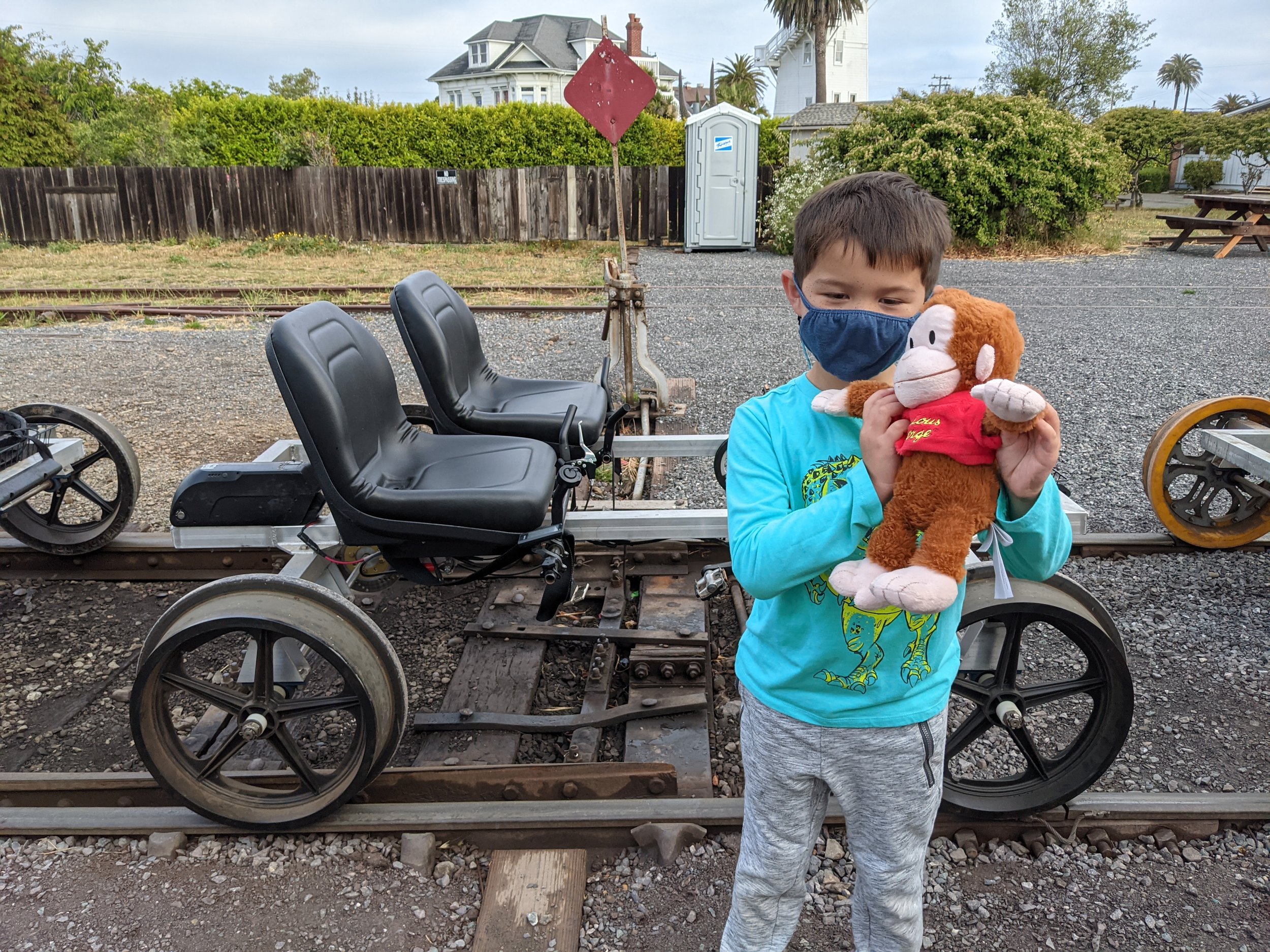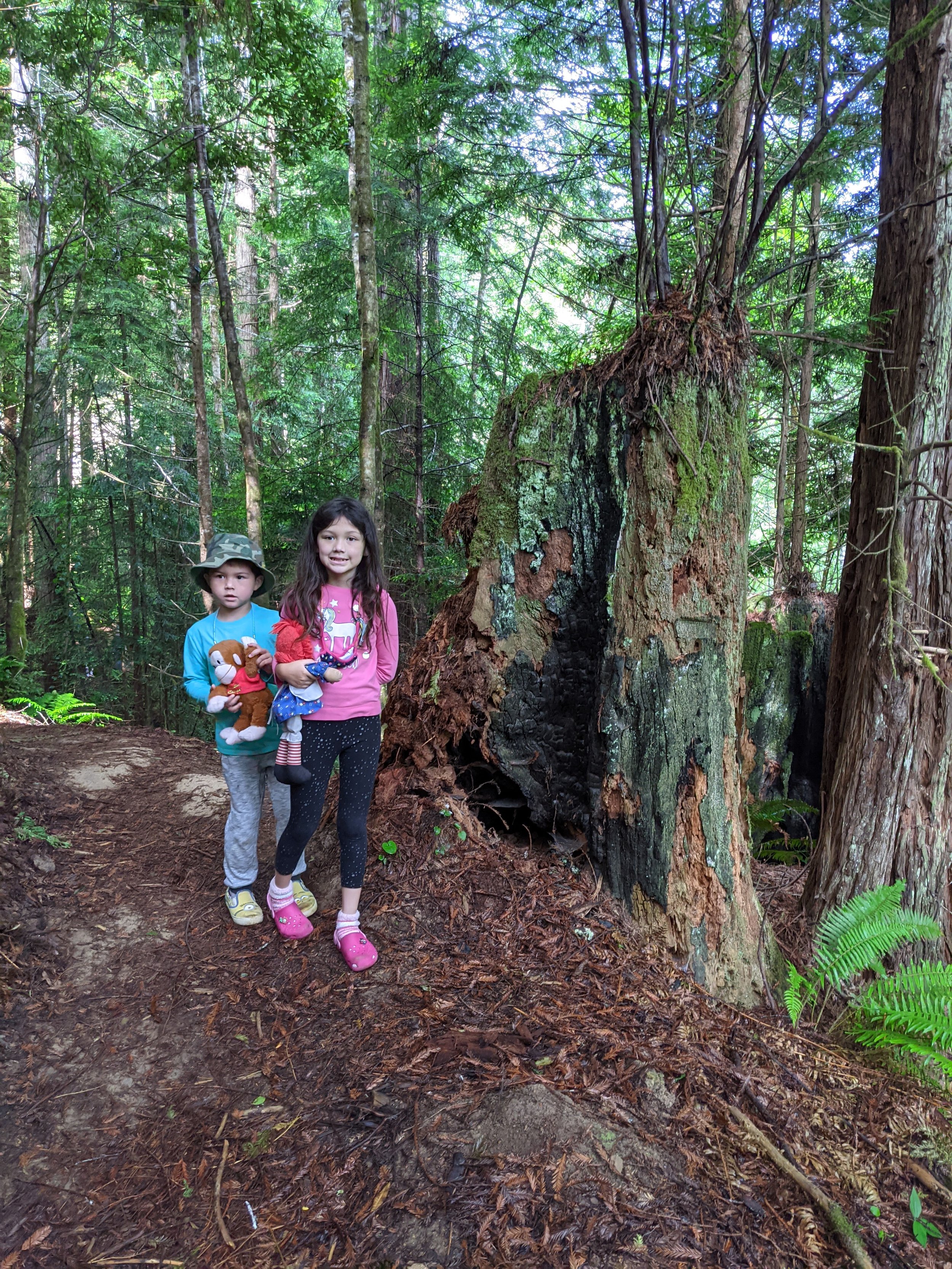To call Fort Bragg a quaint coastal town would be an understatement. Tucked in the upper left hand of California, the onetime hub of the lumber industry sits at the edge of the Pacific Ocean and is surrounded by redwoods. It’s also home to the Skunk Train, a heritage railway that up to a few years ago was able to take weekend visitors on a forty mile tour through the middle of an old growth forest. That is, until the spring of 2013 when a series of tunnel collapses along the route left the company with little more than three miles of track. According to SF Gate, when it was up and running its complete route, the railway was responsible for 50,000 visitors a year. Clearly, the local economy was depending on a draw now that the train was not able to deliver its normal run. The innovative solution to the problem was something called a railbike.
Gathered at the depot and ready to go.
The kids loved that logo.
A railbike is a cleverly-engineered, human-powered affair to get out of town on a set of train tracks. The two seat bikes are built off of an aluminum frame making them light and easy to pedal. In case riders haven’t been putting in the miles on the road back at home, they are equipped with an electric assist motor that allows riders to take in the scenery without breaking a sweat . As light as they are, safety is at the heart of the design. All railbikes have disc brakes, seat belts, and riders are required to wear helmets. In addition, they ride on plastic wheels so they run in near silence as riders cut out and get away from it all. As an added bonus, since the bike rides on rails, there’s no need to steer. All riders have to do is pedal and take in the experience.
Patiently awaiting instructions.
Looking as about as 2021 as a photo gets.
We met up with our guides for an orientation before our departure from the Skunk Train depot. Doubling as a well appointed gift shop with old time charm, the depot sits next to the Pacific Ocean and is worth a stop even if a trip out on the rails isn’t in the cards. After crossing a city street and sailing past the town’s graveyard, the route we were on was swallowed up by an ancient forest. Aside from the tracks and several trestles, signs of civilization slipped away as we moved deeper into it. The air was cool and the light was filtered by the canopy. Even on the hottest days, I can’t imagine anyone getting overly blasted by the sun. Trees, ferns, and the meandering Puddle Creek served as just the thing we needed as our reintroduction to the world after a year and a bit in Covid isolation.
Even the moss was overgrown.
Trees, trestles, and fresh air.
Pulling into Glen Blair Junction.
After several miles of meditative bliss on the rails, it was time for a layover in Glen Blair Junction. While the guides set up the turntable and spun the bikes back around the direction from whence they came, we were left to their own devices. The options are pretty simple: sit at the picnic tables and listen to the birds tweet, or take in a mild hike.
That tunnel up ahead was the driving force of the Skunk Train Railbike adventure.
We opted for the hike. The trail is immaculately well taken care of. Aside from the trees, plan on seeing plenty of ferns and mushrooms in the understory. While the trail does have a climb, like all things on the railbikes trip, ease of use is at the heart of it. My five year old was able to make the trek with nary a peep. It loops and eventually ends with an overhead view of the Glen Blair Junction. By the time we made it back down the hill, it was time for us to depart and make our return to town.
Great spot for a photo.
A year in the same zip code is a long time.
The view of Glen Blair Juntion.
The whole trip was about three hours total. This gave us plenty of time to take in Glass Beach before we got back on the road and headed to parts northward. For anyone who may be interested in a trip that’s a bit more strenuous and more of a time commitment, there is a new adventure available since we took our outing. If the grove looks at all familiar that may be because woods like these just a few miles away doubled as the forest moon Endor in the filming of The Return of the Jedi.
We were assured those weren’t blaster marks left from the production of The Return of the Jedi.
Skunk Train Railbikes
100 West Laurel Street
Fort Bragg, California 95437
707 964-6371
Looking for somewhere to eat? Make a trip to Princess Seafood. Interested in other unique rail experiences? In Los Angeles take a look at Angel’s Flight. In Sacramento, make a visit to the California State Railroad Museum.
This post is based on a visit made on June 12, 2021













